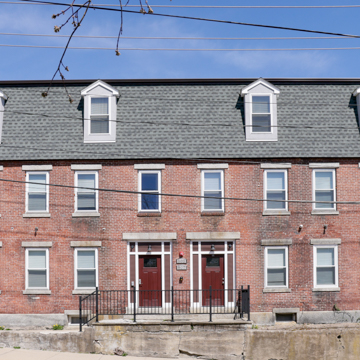The mansarding of both towers and top floors of the tall Globe Mill complex at the horseshoe bend of the river directly opposite Market Square made it a dominating element in nineteenth-century panoramas of Woonsocket. It culminated the achievement of the brothers Dexter and George C. Ballou, who became the first big textile barons of the city. It is all gone now, except for scraps of its housing. The remnants of the Globe Mill village offer one of the best surviving remains of company-built mill housing dating from the early through the mid-nineteenth century.
At 805–807 Front Street is the mansarded brick Globe boardinghouse of 1874 (now run down), for single workers. Across the street, at 810–816 Front Street, is a much earlier example of the company's housing. Built in 1830 as part of the first development of the Globe Mills (begun in 1827), this tenement, though remodeled, clearly was designed in the Federal vernacular typical in this period. Around the corner on Lincoln Street, the two-and-one-half-story tenements (1865) that line both sides of the street reveal the longevity of this basic gable-roofed dwelling type.










